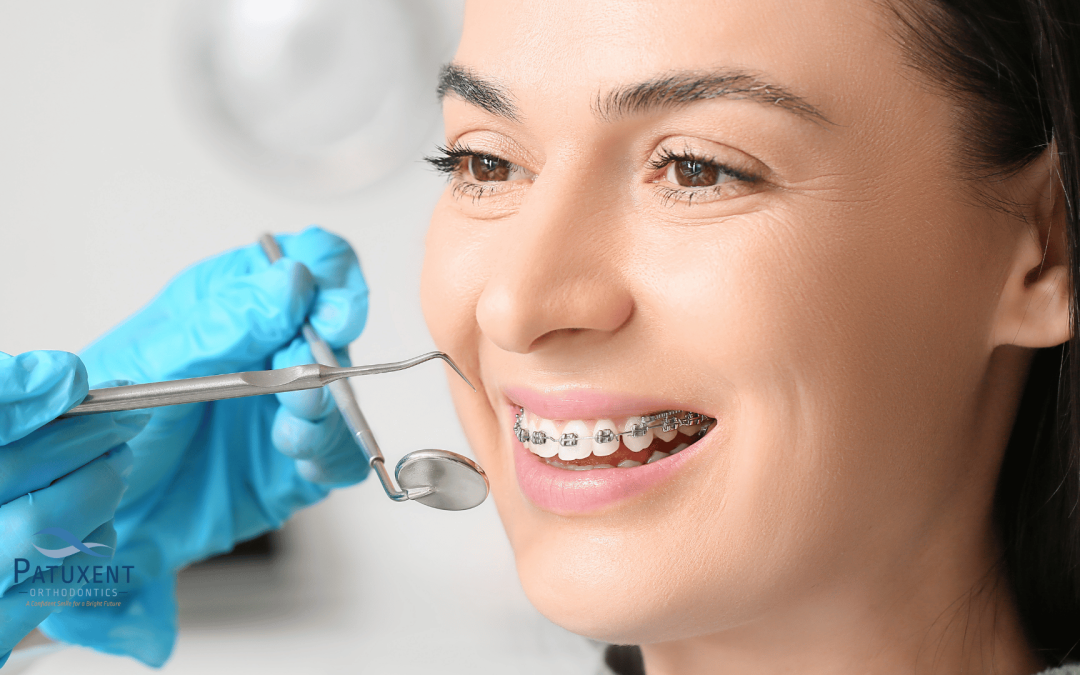Wisdom teeth often can’t help but make their grand entrance with a bit of drama.
Impacted wisdom teeth, hidden beneath the surface, can be the secret agents of discomfort in your mouth.
But what exactly are they, and why do they decide to stay undercover?
We’ll delve into the world of impacted wisdom teeth, uncovering why they become impacted and the orthodontic adventures that ensue!
What Is an Impacted Wisdom Tooth?
Wisdom teeth, also known as third molars, are the last set of teeth to emerge in your oral cavity—sometime between the ages of 17 and 25.
When there isn’t adequate for them to break through the gums, they become “impacted.”
Imagine a tooth trying to squeeze into a crowded elevator—it’s a tight fit, and sometimes, it just can’t make it.
4 Types of Impacted Wisdom Teeth

- Vertical Impaction: The impacted wisdom tooth is upright, just like it’s supposed to be, although still stuck under the gum.
- Horizontal Impaction: In this scenario, the impacted wisdom tooth is completely horizontal and pushing against the nearby teeth.
- Mesial Impaction: The wisdom tooth is angled towards the front of the oral cavity. Eager to emerge, it bumps into the tooth in front of it—as if trying to cut in line.
- Distal Impaction: The wisdom tooth angles towards the back of the oral cavity. It’s like it’s trying to back away from the spotlight, getting stuck in the process.
5 Causes Behind Impacted Wisdom Teeth

- Not Enough Room: The most common reason for impacted wisdom teeth is a lack of space. Modern human jaws are often too small for these extra teeth.
- Evolution at Play: Humans have evolved over thousands of years, and our jaws have become smaller. But our wisdom teeth didn’t get the memo. They still show up, even though there’s insufficient room for them.
- Awkward Angles: Instead of coming up straight, wisdom teeth might decide to lean forward, backward, or even sideways.
- Gum and Bone Issues: Sometimes, the gums and bone around the wisdom teeth don’t cooperate, holding them back.
- Genetics: If your parents had impacted wisdom teeth, you’re more likely to have them, too.
6 Symptoms of Impacted Wisdom Teeth

- Pain and Discomfort: This isn’t your everyday toothache; it’s more like a persistent pain in the back of your oral cavity. It comes and goes, but when it’s there, you know it.
- Gum Swelling: Your gums might get swollen near the impacted tooth.
- Red or Bleeding Gums: Red, sore, or bleeding gums around the impacted tooth are a sign of trouble.
- Halitosis or an Unpleasant Taste: Impacted wisdom teeth may cause bad breath or a nasty taste in your mouth.
- Difficulty Opening Your Oral Cavity: If opening your mouth wide feels like a challenge, it might be due to an impacted wisdom tooth.
- Swollen Jaw: The area around your jaw might swell up as a reaction to the impacted tooth.
Impacted Wisdom Tooth Diagnosis
Dentists and oral surgeons start their impacted wisdom tooth diagnosis with a conversation.
They’ll ask you about any symptoms you’re experiencing, like pain in the back of your mouth or trouble chewing.
Next, a physical examination.
They’ll check inside your mouth for signs of impacted wisdom teeth, such as swollen gums, redness, and any signs of infection.
X-rays are helpful here because they let dentists and oral surgeons see what’s happening beneath the surface. They can spot wisdom teeth hiding under the gums or stuck in the jawbone.
Based on all this information—the chat, the examination, and the X-rays—dentists and oral surgeons determine if your wisdom teeth are impacted. They’ll look at how the teeth are growing, checking if there’s enough space for them and if they’re causing any orthodontic problems.
Should I Have My Impacted Wisdom Teeth Removed?

Not all impacted wisdom teeth need to be shown the door.
Let’s start with a partially impacted wisdom tooth.
Partially impacted teeth can be tricky because they create a nook where bacteria can party, leading to problems like pain, infection, and damage to neighboring teeth.
In such cases, your dentist might recommend removal to prevent future dental drama.
Then, there are asymptomatic impacted wisdom teeth, which cause no discomfort at all—you might not even know they’re there!
But just because they’re quiet doesn’t mean they’re harmless. They can still cause damage to other teeth or serve as potential hideouts for bacteria. Dentists often watch these silent troublemakers with regular check-ups and X-rays.
The process of removing an impacted wisdom tooth is like a well-orchestrated mini-mission inside your mouth:
- Consultation and X-rays: First, you meet with your dentist or oral surgeon. They’ll take X-rays to clearly understand what’s going on beneath your gums.
- Anesthesia: On the day of the procedure, you’ll be given anesthesia—local (numbing just the area around the tooth), sedation (you’re relaxed but awake), or general (you’re completely asleep).
- Removal: The surgeon gently opens the gum tissue over the impacted tooth. If the tooth is stubbornly nestled in the jawbone, they might also remove a small piece of the bone. Finally, they carefully extract the troublesome tooth.
- Stitches and Gauze: After removing the tooth, your oral surgeon will stitch up the area to expedite healing. You’ll also bite down on a piece of gauze to control any bleeding.
Recovery after Impacted Wisdom Tooth Removal
The recovery time after wisdom teeth removal varies from patient to patient, but generally, you should be back to feeling like your usual self in a week or two.
First, you’ll be dealing with swelling and discomfort, which you’ll manage by applying an ice pack to your cheek. It’s like giving your face a mini cold vacation to reduce swelling. Your dentist will likely recommend or prescribe pain relievers to lower your discomfort levels further.
You’re looking at soft, easy-to-eat foods for the first few days. Think yogurt, soup, and smoothies.
Rest is your best friend during this time—the more you rest, the quicker your mouth heals. Avoid strenuous activities and give yourself a chance to relax.
Finally, oral hygiene remains a VIP in your daily routine. Your dentist will guide you on how to keep the area clean without disturbing the healing process.
Frequently Asked Questions about Impacted Wisdom Teeth
Do Impacted Wisdom Teeth Cause Headaches?

Impacted wisdom teeth can indeed be responsible for headaches.
An impacted wisdom tooth creates pressure in the mouth and jaw area, leading to discomfort, including headaches.
Also, when you have an impacted wisdom tooth, you might unknowingly change how you chew or even how you hold your jaw due to the discomfort.
These changes can strain your jaw muscles and joints, leading to tension headaches.
Are Impacted Wisdom Teeth Common?
Impacted wisdom teeth are quite common, much like getting a flat tire on a long journey.
These late-arriving molars at the back of your mouth often find themselves with nowhere to go, partly because our modern jaws are usually not large enough to accommodate these extra teeth. Many patients face this issue in their late teens or early twenties.
Are Impacted Wisdom Teeth Preventable?
Unfortunately, impacted wisdom teeth are mainly due to factors out of our control, like genetics and the size of our jawbones.
If your parents had impacted wisdom teeth, you might be more likely to have them, too.
Moreover, some of us are born with larger jaws and, therefore, have enough room for all our pearly whites, including wisdom teeth. Others have smaller jaws, which means less room for when those late-arriving wisdom teeth show up.
Do Impacted Wisdom Teeth Cause TMJ Pain?

Wisdom tooth impaction changes how you bite and chew, which might put extra stress on your TMJ.
If impacted wisdom teeth change how your jaw moves, your TMJ must adapt to the new state of affairs, which may lead to pain and discomfort.
Is There a Link between Impacted Wisdom Teeth and Ear Pain?
The connection between impacted wisdom teeth and ear pain is more about proximity and shared nerve pathways than one directly causing the other.
Your mouth and ears are like neighbors in a close-knit community—what happens in one sometimes affects the other.
Since the nerves in your jaw and ears are interconnected, this discomfort caused by impacted wisdom teeth may feel like it’s extending into your ear, even though the actual problem is with your tooth.
Impacted Wisdom Teeth: The Hidden Trouble in Your Smile!
Contact Patuxent Orthodontics if orthodontic care is the solution to your dental woes. Whether you want to learn more about the benefits of orthodontic care or have questions about the process, use our live chat, call (240) 802-7217, or message us through our Contact Us page to connect with our friendly staff today and book a complimentary consultation!
Our office, located at 44220 Airport View Dr., Hollywood, MD 20636, proudly serves Maryland’s Patuxent area, as well as the Greater Washington DC area. So, if you’re residing in Hollywood, Wildewood, or Leonardtown and are looking for one of the best orthodontists in Maryland, don’t hesitate to visit our office!
We also invite you to keep up with our blog to get answers to many of the frequently asked questions about maintaining your perfect smile, and follow us on Facebook and Instagram to become a part of our smiling community!
References
- “Impacted Tooth.” Mount Sinai Health System, www.mountsinai.org/health-library/diseases-conditions/impacted-tooth. Accessed 2 Jan. 2024.
- “Impacted Wisdom Teeth.” Mayo Clinic, Mayo Foundation for Medical Education and Research, www.mayoclinic.org/diseases-conditions/wisdom-teeth/diagnosis-treatment/drc-20373813. Accessed 2 Jan. 2024.
- “Impacted Wisdom Teeth: Symptoms and Removal.” Medical News Today, MediLexicon International, www.medicalnewstoday.com/articles/188660. Accessed 2 Jan. 2024.
- “Impacted Wisdom Teeth: Symptoms, Signs, Removal & Recovery.” Cleveland Clinic, my.clevelandclinic.org/health/diseases/22296-impacted-wisdom-teeth. Accessed 2 Jan. 2024.
- “Impacted Wisdom Tooth: Treatment, Recovery, and More.” Healthline, Healthline Media, www.healthline.com/health/impacted-wisdom-tooth. Accessed 2 Jan. 2024.











